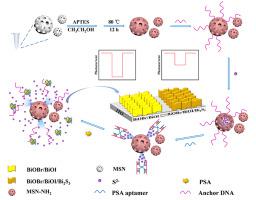Analytica Chimica Acta ( IF 5.7 ) Pub Date : 2023-06-23 , DOI: 10.1016/j.aca.2023.341541 Xue Dong 1 , Hanyu Wang 1 , Xiang Ren 1 , Hongmin Ma 1 , Dawei Fan 1 , Dan Wu 1 , Qin Wei 1 , Huangxian Ju 2

|
Development of new strategies in photoelectrochemical (PEC) sensors is an important way to realize sensitive detection of biomolecule. In this study, mesoporous silica nanospheres (MSNs)-assisted split-type PEC aptasensor with in situ generation of Bi2S3 was proposed to achieve reliable detection of prostate-specific antigen (PSA). To be more specific, this bioresponsive release system will release large amounts of Na2S by the reaction between PSA and aptamer that capped Na2S-loading MSNs. Next, the Na2S reacts with Bi to yield BiOI/BiOBr/Bi2S3 composite, which leads to an alteration in the electron-hole transfer pathway of the photoelectric material and a decrease in the response. As the PSA concentration increases, more Na2S can be released and lower photocurrent is obtained. The linear range under the optimal experimental conditions is 10 pg·mL−1-1 μg⋅mL−1, and the detection limit is 1.23 pg⋅mL−1, which has satisfactory stability and anti-interference.
中文翻译:

原位形成 Bi2S3 破坏 I 型异质结用于分体式光电化学适体传感器
开发光电化学(PEC)传感器新策略是实现生物分子灵敏检测的重要途径。在这项研究中,提出了介孔二氧化硅纳米球(MSN)辅助的分裂型PEC适体传感器原位生成Bi 2 S 3以实现前列腺特异性抗原(PSA)的可靠检测。更具体地说,这种生物响应性释放系统将通过PSA与负载Na 2 S的MSN的适体之间的反应释放大量的Na 2 S。接下来,Na 2 S与Bi反应生成BiOI/BiOBr/Bi 2 S 3复合材料,这导致光电材料的电子-空穴传输路径的改变和响应的降低。随着PSA浓度的增加,可以释放更多的Na 2 S并获得更低的光电流。最佳实验条件下线性范围为10 pg·mL −1 -1 μg·mL −1,检出限为1.23 pg·mL −1,具有良好的稳定性和抗干扰性。











































 京公网安备 11010802027423号
京公网安备 11010802027423号